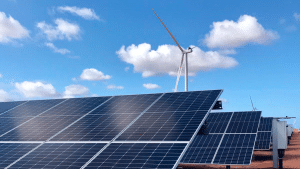With more than $18 million allocated for 12 projects under the first round of the Emerging Aviation Technology Partnerships (EATP) program, the Australian Government has collaborated with industry to ensure the uptake of emerging aviation technology in Australia.
In round one of the $32.6 million EATP competitive grants programs, AMSL Aero, a start-up developing world-leading electric vertical take-off and landing (eVTOL) aircraft technology, was chosen alongside 11 other firms.
The ‘Vertiia’ eVTOL aircraft technology, developed by AMSL Aero, is marketed as the first eVTOL with a 1,000km range and is said to be powered by renewable electricity and hydrogen fuel.

Swinburne University of Technology’s Air Hub was also given funding for its initiative to build and incorporate a hydrogen fuel cell into a drone with ground and flight testing.
Praxis Labs, another grant recipient, is creating structural solar surfaces for the wings of a future fleet of Australian electric aircraft.
The Emerging Aviation Technology Partnerships (EATP) program will invest $32.6 million until June 2024 to improve Australian aviation’s competitiveness, effectiveness, and sustainability.
The goal of the EATP program
The former government pledged $32.6 million over two years to launch the Emerging Aviation Technology Partnerships Program as part of the Digital Economy Strategy, unveiled on May 6, 2021.
Until 30 June 2024, the program will foster industry-industry strategic collaborations utilising cutting-edge aviation technology to solve community needs, particularly in remote Australia.
The program’s goal is to promote and facilitate the development and application of cutting-edge aviation technology to enhance the competitiveness and dependability of Australian aviation.
The program strives to increase employment in the aviation industry, enhance the supply chain and market effectiveness, and strengthen ties with remote and regional areas, especially Indigenous people, to achieve the program’s goal. Through new technologies, the program will also help Australian firms become more efficient in their operations and reduce their carbon footprints.
Through the program, the department will collaborate with businesses to evaluate cutting-edge aviation technologies through five focus areas of pilot projects:
- Digital farming
- Connecting regional communities
- Boosting regional supply chains
- Improving health outcomes for remote indigenous communities
- Manufacturing in emerging aviation technology.
Energy Matters has been a leader in the renewable energy industry since 2005. We can connect you with our trusted local installers, who will provide up to 3 FREE quotes for your home or business solar energy system. Complete our quick quiz and begin your solar journey today!
Emerging aviation technologies at a glance
Drones and electric vertical take-off and landing vehicles (eVTOLs) are the two main developing aviation technology types used in Australia.
A drone is a small uncrewed aircraft mostly used for entertainment, small item delivery, and situational awareness, such as watching over farm animals or a wildfire that has not yet been contained.
Electric vertical take-off and landing (eVTOL) craft are larger than drones and frequently fly without wings. They may perform activities that require more time in the air and, eventually, serve as air taxis because they have a more enormous range and capacity than drones.

New career opportunities and services are being made possible by expanding emerging aviation technology like drones, remotely piloted aircraft, improved air mobility, and electric vertical take-off and landing vehicles.
AMSL Aero’s Vertiia: A highly effective air taxi
Andrew Moore and Siobhan Lyndon (husband and wife), established AMSL Aero in June 2017 in Australia. Andrew Moore has over 20 years of experience in senior positions in the aerospace industry and is a licenced pilot and aeronautical engineer. Siobhan has over 20 years of experience in the technology, telecoms, and professional services sectors, including a decade at Google, where she held senior leadership positions across the globe. She holds degrees in both law and business.

A relationship between AMSL Aero and Careflight, a preeminent Australian aeromedical organisation, was previously announced.
Additionally, AMSL Aero has been awarded contracts by the Australian Department of Defence via the Defence Innovation Hub.
The aircraft was first code-named the Verti-plane but quickly changed its name to Vertiia. It is the world’s most effective electric vertical takeoff and landing aircraft. Because of its distinctive aerodynamic and structural design, it can travel farther while consuming less energy.
Vertiia offers a novel mode of transportation that will help its customers save valuable time by taking off and landing like a helicopter without needing a runway.
Vertiia can travel 250 kilometres on electric battery power before requiring a recharge when cruising at 300 kilometres per hour. The hydrogen-powered Vertiia is intended to go up to 1000 kilometres continuously.
Vertiia will offer a new, secure, reasonably priced transportation designed explicitly for the aeromedical, emergency services, and passenger markets.














































